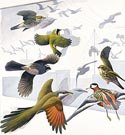Some migratory birds just don’t like urban areas: Study
 Washington, Apr 2: A six-year study in the United States has come up with fresh evidence that the populations of some species of migratory birds are threatened by urbanization, countering the age-old explanation of why urban areas are so hostile to some kinds of birds.
Washington, Apr 2: A six-year study in the United States has come up with fresh evidence that the populations of some species of migratory birds are threatened by urbanization, countering the age-old explanation of why urban areas are so hostile to some kinds of birds.
This study was carried out under the supervision of Amanda Rodewald, associate professor of wildlife ecology at Ohio State University’s School of Environment and Natural Resources.
Rodewald said that it was long believed by ecologists that common nest predators in urban areas – such as house cats and raccoons – were destroying eggs or killing young birds in greater numbers than in rural areas.
However, this study tested that assumption through monitoring natural nests over several years and it was found that it was not the predators that were the main problem, but the birds just didn’t seem to like urban areas and gave up more easily.
“So much of the world is becoming urbanized. From a conservation perspective, really understanding how animals respond to urbanization is going to be important for protecting biodiversity,” said Rodewald.
The study indicated that urban areas attracted lower-quality birds which, compared to those in rural areas, arrived later in the spring, left earlier in the fall, made fewer nesting attempts and were much less likely to return to nesting spots from year to year.
“There is something about these urban forests that strikes the birds as unsuitable. Even when they try nesting, they are less likely to renest after failure or to return in subsequent years,” she said.
For the study the researchers monitored nesting success in the Columbus area of Acadian Flycatchers, a migratory bird that is a relatively common summer resident in wooded areas across much of the eastern United States. For six years they monitored 387 nests and 167 breeding pairs of Acadian Flycatchers who lived in 35 forest stands in and around Columbus.
The findings revealed striking differences in the number of young produced by flycatchers on the basis of how urban their nesting sites were. Non-urban sites averaged nearly two young produced each nesting season, while urban nests averaged about one young per year. Even the rate of nest survival ranged widely across sites, with 11 to 55 percent of nests successfully raising young. However, nest survival was not related to urbanization.
The researchers found out how urban a nest site was by measuring the percentage of land within a 1 kilometer radius that was covered by a building, parking lot, mowed lawn or other man-made surface.
Rodewald said that though this study did support the earlier research in saying that urban areas had more predators, such as raccoons, when compared to rural areas, however, these predators were not raiding nests more often in urban areas.
So, they went on to find out what was reducing the number of young produced and speculated that one problem could be that the adults birds who nested in urban areas tended to be slightly smaller than those in rural areas.
“The birds are sorting out, and it appears the lower-quality birds are the ones forced into urban areas. That means they have no other options – there are not better rural areas for them to go,” said Rodewald.
However, the researchers could not find what is it that Acadian Flycatchers and other migratory birds did not seem to like about urban areas.
“Is it the noise, the amount of artificial lights at night, the local vegetation? We just don’t know,” she said.
But the researchers are testing several theories, to find out the exact reason behind this.
One can be that many of the urban forests were dominated by Amur Honeysuckle plants, an invasive shrub native to Asia that is often used as ornamental plants in urban areas. Honeysuckles often made the understory of urban forests thicker than those in rural areas, which Acadians may not like for some reason. In fact the researchers are removing the plants in some forests to see if that helps Acadian Flycatchers in those areas.
The findings suggest that conservation of birds in urban areas may be more complex than many ecologists assumed.
The findings of this study were published in a recent issue of the Journal of Animal Ecology. (ANI)